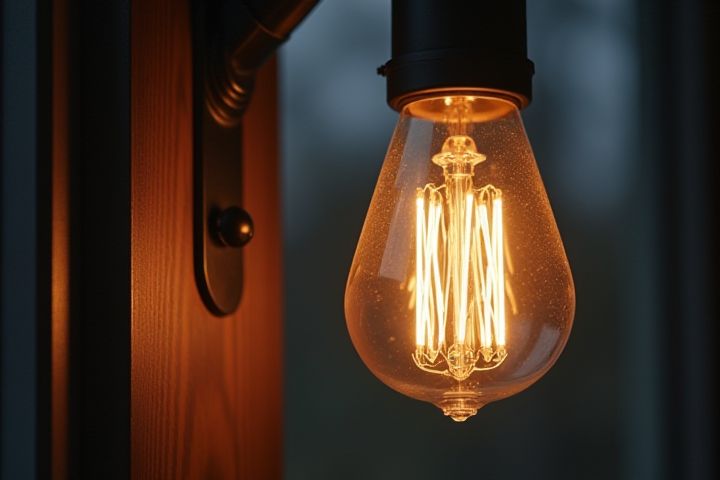
Adjusting house lighting can significantly enhance the ambiance and functionality of your space. Begin by assessing the types of bulbs in use; LED bulbs are energy-efficient options that provide brightness and longevity. Consider installing dimmer switches to control light intensity, allowing you to create different moods in various rooms. Incorporate layered lighting--such as ambient, task, and accent lighting--to achieve a balanced and versatile illumination setup. Finally, utilize natural light by strategically placing mirrors and light-colored decor to reflect daylight, improving the overall brightness of your home.
How To Adjust House Lighting
Understand natural light sources
Natural light sources, such as windows and skylights, play a crucial role in enhancing the luminosity of your home. To optimize the lighting in your space, consider the direction and intensity of sunlight during different times of the day. For example, south-facing windows typically provide consistent light, while north-facing options offer softer illumination. By strategically placing mirrors or light-colored decor near these sources, you can effectively reflect and diffuse light throughout your rooms.
Select appropriate bulb types
Choosing the right bulb type significantly impacts your home's lighting quality and energy efficiency. LED bulbs, for example, consume about 75% less energy than incandescent bulbs and last up to 25 times longer, making them a cost-effective choice. For accent lighting, consider using GU10 or MR16 bulbs, which provide focused beams that highlight artwork or architectural features. Your living spaces can benefit from a warm white light, around 2700K to 3000K, creating a cozy atmosphere while still ensuring visibility and comfort.
Consider light color temperatures
When adjusting your house lighting, consider the color temperature measured in Kelvin (K) to create the desired ambiance. Warm white light (2700K-3000K) is ideal for cozy spaces like living rooms, while cool white (3500K-4100K) is better suited for areas requiring focus, such as kitchens and home offices. For task-oriented spaces, using daylight bulbs (5000K-6500K) can enhance visibility and energy. By selecting the right color temperatures, you can significantly impact the mood and functionality of each room in your home.
Use dimmer switches
Using dimmer switches is an effective way to adjust house lighting for ambiance and energy efficiency. These devices allow you to control the brightness of your lights, providing flexibility to create a cozy atmosphere or enhance visibility when needed. Installing dimmer switches is straightforward, as they can replace standard light switches in most homes, accommodating various light types including LED, incandescent, and halogen bulbs. By utilizing dimmer switches, you can achieve the perfect lighting level for any occasion, ultimately elevating your living space's aesthetic.
Layer different light sources
To achieve optimal house lighting, layer different light sources including ambient, task, and accent lighting. Ambient lighting, such as overhead fixtures or recessed lights, typically provides 100-300 lumens per square foot, ensuring overall illumination. Task lighting, like desk lamps and under-cabinet lights, should ideally deliver 500 lumens or more, which enhances functionality in work areas. Finally, accent lighting, featuring spotlights or wall sconces, can highlight artwork or architectural features, adding depth and character to your living spaces.
Employ task lighting
Task lighting enhances your home's functionality by providing focused illumination where it's needed most, boosting productivity and reducing strain on your eyes. Incorporate adjustable desk lamps with brightness settings in workspaces, use under-cabinet lights in kitchens for detailed tasks, and consider reading lamps with directional features in living areas. LED lights offer energy efficiency, lasting up to 25,000 hours, while varying color temperatures can create the right ambiance for different tasks. To personalize your lighting, experiment with fixtures, like pendant lights over work surfaces or adjustable wall sconces, ensuring your space is both functional and aesthetically pleasing.
Pay attention to fixture placement
Fixture placement plays a crucial role in achieving optimal house lighting. For a balanced ambience, position fixtures approximately 12-18 inches from walls and ensure they are evenly spaced throughout the room. Overhead fixtures should be centered, while task lighting needs to be placed closer to areas like desks or kitchen counters, typically 24-30 inches above surfaces. Adjusting these placements can significantly enhance the room's overall functionality and aesthetic appeal.
Implement smart lighting controls
Implementing smart lighting controls can revolutionize your home's ambiance and energy efficiency. By utilizing systems such as smart bulbs, dimmers, or smart switches, you can remotely adjust brightness levels, color temperatures, and even schedules through your smartphone or voice commands. Many smart lighting solutions connect to home assistants like Amazon Alexa or Google Home, allowing for effortless control and automation of up to 50 different bulbs or fixtures. You not only enhance the aesthetics of your space but can also reduce energy consumption by up to 30% with programmable settings.
Utilize reflective surfaces
Utilizing reflective surfaces in your home can significantly enhance your lighting design, creating a brighter and more inviting atmosphere. Incorporating mirrors, glossy paint, or glass elements can amplify natural and artificial light, distributing it more efficiently throughout the space. For optimal results, position mirrors opposite windows to maximize daylight reflection or use metallic finishes on furniture to bounce light back into the room. By carefully selecting these reflective surfaces, you can achieve a well-lit environment that effectively elevates the overall aesthetic of your home.
Balance direct and indirect lighting
To achieve balanced lighting in your home, consider a mix of direct and indirect sources, such as combining overhead fixtures with floor lamps and wall sconces. Direct lighting, like pendant lights or spotlights, highlights specific areas, while indirect lighting, from sources such as cove lighting or lamps with diffusers, creates a warm ambiance by reflecting light off surfaces. Aim for a lighting ratio of about 70% indirect to 30% direct for a well-rounded effect that reduces shadows and enhances comfort. Experiment with dimmers to adjust brightness levels according to mood, time of day, or activity, ensuring your space feels inviting and functional.
